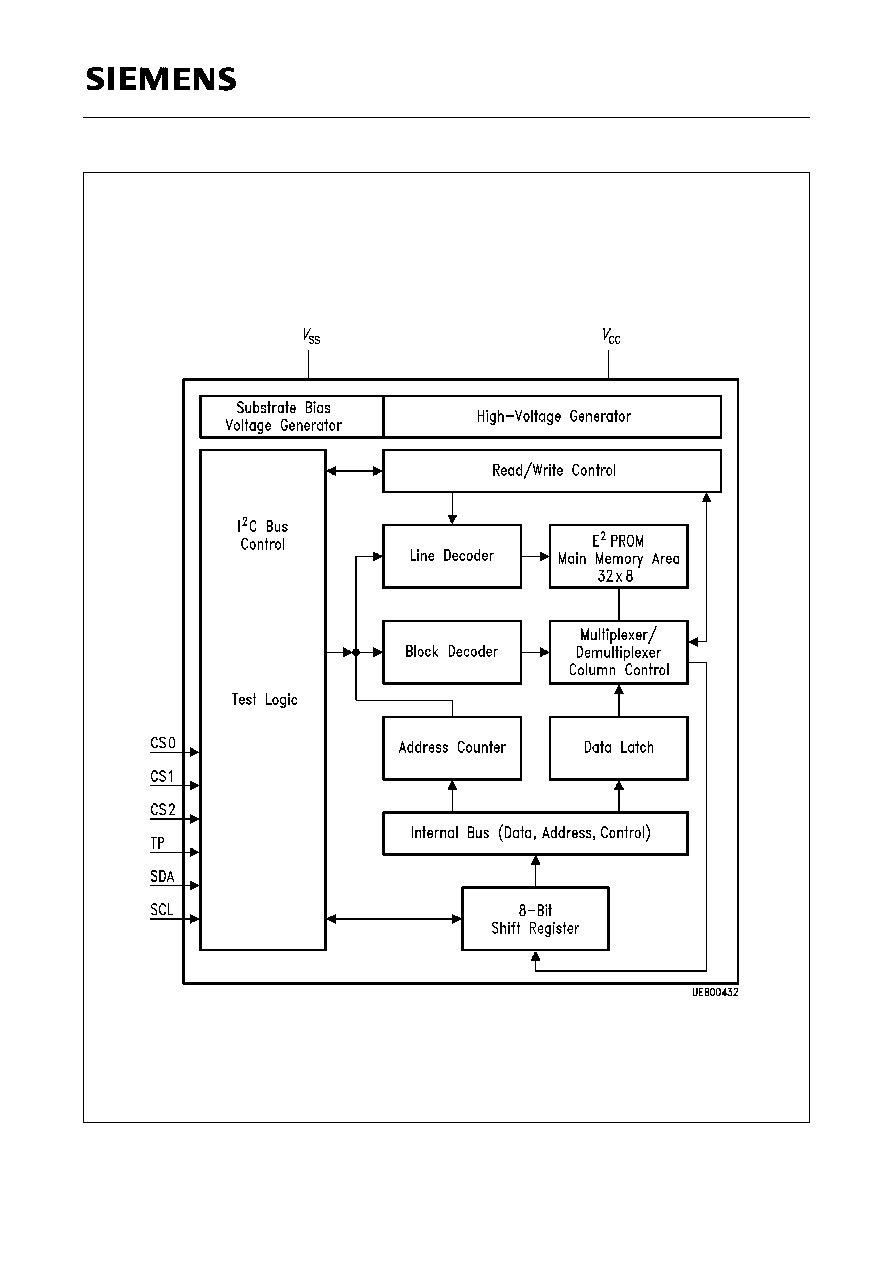
Circuit Description
I
2
C Bus Interface
The
I
2
C Bus is a bidirectional 2-line bus for the transfer of data between various integrated circuits.
It consists of a serial data line SDA and a serial clock line SCL. The data line requires an external
pull-up resistor to
V
CC
(open drain output stage).
The possible operational states of the
I
2
C Bus are shown in figure 1. In the quiescent state, both
lines SDA and SCL are high, i.e. the output stage of the data line is disabled. As long a SCL remains
"1", information changes on the data bus indicate the start or the end of data transfer between two
components.
The transition on SDA from "1" to "0" is a start condition, the transition from "0" to "1" is a stop
condition. During a data transfer the information on the data bus will only change while the clock line
SCL is "0". The information on SDA is valid as long as SCL is "1".
In conjunction with an
I
2
C Bus system, the memory component can operate as a receiver and as a
transmitter (slave receiver or slave transmitter). Between a start and stop condition, information is
always transmitted in byte-organized form. Between the falling edge of the eighth clock pulse and
a ninth acknowledge clock pulse, the memory component sets the SDA-line to low as a confirmation
of reception, if the chip select conditions have been met. During the output of data, the data output
of the memory is high in impedance during the ninth clock pulse (acknowledge master).
The signal timing required for the operation of the
I
2
C Bus is summarized in figure 2.
Nonvolatile Memory 2-Kbit E
2
PROM
with
I
2
C Bus
Preliminary Data
MOS IC
SDA 2526-5
P-DIP-8-1
Features
q
Word-organized programmable nonvolatile memory in
n-channel floating-gate technology (E
2
PROM)
q
256
�
8-bit organization
q
Supply voltage 5 V
q
Serial 2-line bus for data input and output (
I
2
C Bus)
q
Reprogramming mode, 10 ms erase/write cycle
q
Reprogramming by means of on-chip control (without
external control)
q
Check for end of programming process
q
Data retention > 10 years
q
More than 10
4
reprogramming cycles per address
q
Compatible with SDA 2526. Exceptions: Conditions for
total erase and current consumption
I
CC
Type
Ordering Code
Package
SDA 2526-5
Q67100-H5095
P-DIP-8-1
Semiconductor Group
17
07.94

Semiconductor Group
18
SDA 2526-5
Control Functions of the
I
2
C Bus
The memory component is controlled by the controller (master) via the
I
2
C Bus in two operating
modes: read-out cycle, and reprogramming cycle, including erase and write to a memory address.
In both operating modes, the controller, as transmitter, has to provide 3 bytes and an additional
acknowledge clock pulse to the bus after the start condition. During a memory read, at least nine
additional clock pulses are required to accept the data from the memory and the acknowledge
master, before the stop condition may follow. In the case of programming, the active programming
process is only started by the stop condition after data input (see figure 3).
The chip select word contains the 3 chip select bits CS0, CS1 and CS2, thus allowing 8 memory
chips to be connected in parallel. Chip select is achieved when the three control bits logically
correspond to the selected conditions at the select inputs.
Check for End of Programming or Abortion of Programming Process
If the chip is addressed during active reprogramming by entering CS/E, the programming process
is terminated. If, however, it is addressed by entering CS/A, the entry will be ignored. Only after
programming has been terminated will the chip respond to CS/A. This allows the user to check
whether the end of the programming process has been reached (see figure 3).
Memory Read
After the input of the first two control words CS/E and WA, a resetting of the start condition and the
input of the third control word CS/A, the memory is set ready to read. During acknowledge clock
nine, the memory information is transferred in parallel mode to the shift register. Subsequent to the
falling edge of the acknowledge clock, the data output is low impedance and the first data bit can be
sampled (see figure 4).
With every shift clock, an additional bit reaches the output. After reading a byte, the internal address
counter is automatically incremented when the master receiver switches the data line to "low" during
the ninth clock (acknowledge master). Any number of memory locations can thus be read one after
the other. At address 256, an overflow to address 0 is initiated. With the stop condition, the data
output returns to high-impedance mode. The internal sequence control of the memory component
is reset from the read to the quiescent state with the stop condition.

Semiconductor Group
19
SDA 2526-5
Memory Reprogramming
The reprogramming cycle of a memory word comprises an erase and a subsequent write process.
During erase, all eight bits of the selected word are set into the "1" state. During write, "0" states are
generated according to the information in the internal data register, i.e. according to the third input
control word. After the 27th and last clock of the control word input, the active programming process
is started by the stop condition. The active reprogramming process is executed under on-chip
control.
The time required for reprogramming depends on component deviation and data patterns.
Therefore, with rated supply voltage, the erase/write process extends over max. 20 ms, or more
typically, 10 ms. In the case of data word input without write request (write request is defined as data
bit in data register set to "0"), the write process is suppressed and the programming time is
shortened. During a subsequent programming of an already erased memory address, the erase
process is suppressed again, so that the reprogramming time is also shortened.
Important: Switch-On Mode and Chip Reset
After the supply voltage
V
CC
has been connected, the data output will be in high-impedance mode.
As a rule, the first operating mode to be entered, should be the read process of a word address.
As a result of the built-in "power-on reset" circuit, programming requests will not be accepted
immediately after the supply voltage has been switched on.
Total Erase
Enter the control word CS/E, load the address register with address 0 and the data register with FF
(hex) to erase the entire contents of the memory. Switch input CS2 to "open" immediately prior to
generating the stop condition. The subsequent stop condition triggers a total erase. Upon
termination of "total erase", CS2 must be reconnected to either 0 V or
4.5 V.

Semiconductor Group
20
SDA 2526-5
Pin Configuration
(top view)
Pin Definitions and Functions
Pin No.
Symbol
Function
1
V
SS
Ground
2
CS0
Chip select
3
CS1
Chip select
4
CS2
Chip select 0
V
I
0.2 V; 4.5
V
I
V
CC
open,
condition for delete of the complete memory
5
SDA
Data line
6
SCL
Clock line
7
TP
Test pin
8
V
CC
Supply voltage

Semiconductor Group
21
SDA 2526-5
Block Diagram




